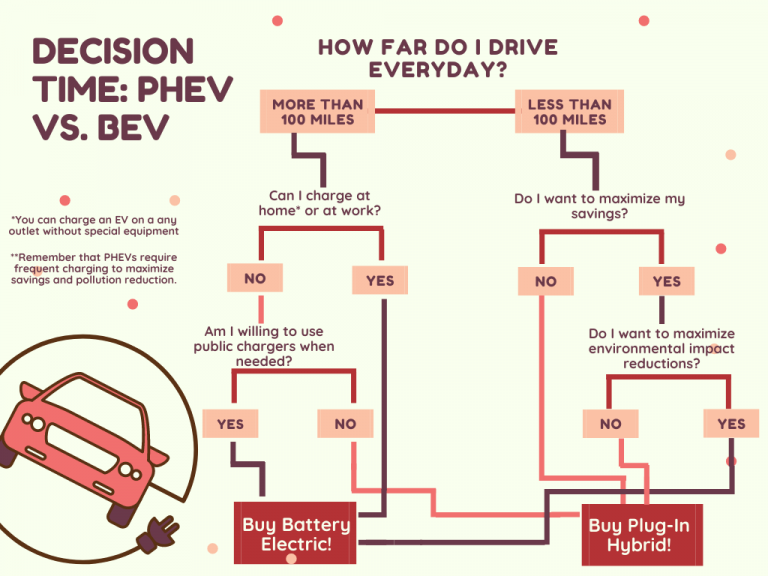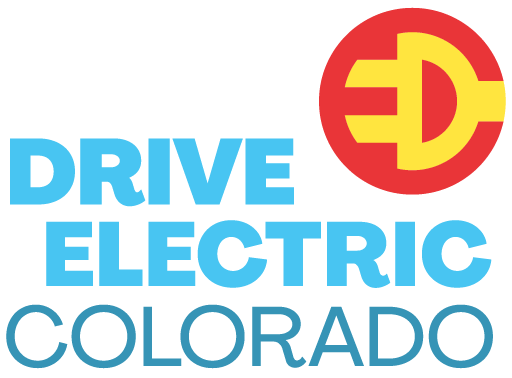Your Guide to Choosing between a PHEV and a BEV
You’ve decided to buy an electric vehicle: congratulations and welcome to the club! Now that you have decided to buy electric, whether for the cost savings, greenhouse gas emissions reductions, or air quality benefits, one question that may be hounding you is which type of electric vehicle to purchase!
The answer to that question is one that depends on so many factors that make up the chaos of your life and your current mobility needs. So, we have created a decision tree to help make the choice a bit simpler. However, decision trees can be limited, so below the graphic you will find a deep dive guide for choosing between a Plug-in Hybrid (PHEV) and a Battery Electric Vehicle (BEV).

Key questions to ask yourself:
How far do you drive in a day?
We recommend that you conduct a “mileage audit” for 1–2 weeks. Recording how often and how much you drive can provide key insight into driving habits that carry heavy weight in the PHEV vs. BEV decision-making process. Simply write down the distance and frequency of your driving during a “typical” week—the results may surprise you!
The average American drives less than 40 miles a day. Currently, all full-battery electric models have ranges above 100 miles. On the flip side, plug-in hybrids tend to have rather short all-electric ranges, landing somewhere between 10–50 miles until the gas engine takes over. To fully take advantage of the electric miles in a PHEV, the driver must be willing to charge on a more frequent basis than a BEV-driver.
Are you able to charge at home or at work?
If you have an outlet within 12–20 feet of where you park your car (garage, driveway, etc), you are able to charge your car. It’s true! Your electric vehicle (whether BEV or PHEV) can charge off a regular 120-Volt outlet. It’s as simple as charging your phone! However, this type of charging is called “trickle charging” for a reason—it is quite slow and can take between 12–15 hours to fully charge your battery. However, many BEV drivers that drive less than 40 miles a day rely on this Level 1 charging daily and do not experience range anxiety because their battery rarely fully depletes.
If you are looking for a faster charge, you can have a Level 2 charger installed in your residence with the help of an electrician—and you may be eligible to receive rebates on these chargers from your local utility and the federal government. Alternatively, your workplace may offer Level 2 charging for employees or may be willing to consider the possibility of installing one with enough employee support. Want help talking to your employer about EV charging? Contact a coach today.
If you live in an apartment complex that does not offer residential charging (again, feel free to reach out to us for help!) or you park on the street, you can rely on public Level 2 or DC fast chargers to get your juice. This is not an ideal situation for most drivers, but many do make it work. PHEVs will charge faster because of the smaller batteries but will require more frequent charging compared to BEVs.
Do you want to maximize financial savings?
Do you want to maximize your savings based off purchase price or total cost of ownership over the vehicle’s lifespan? PHEVs are often cheaper upfront than BEVs because of the smaller batteries. However, PHEV ownership costs are higher than BEVs because PHEVs are less efficient cars and there are more moving parts to break and maintenance.
If you are looking to save money long-term, BEVs are a better option. You will save money in both maintenance and fuel. Additionally, BEVs are eligible for better financial incentives at purchase—including Colorado’s $2,500 incentive, the federal government’s $7,500 incentive*, and potential utility incentives.
*the U.S. EV purchase incentive depends on the manufacturer of your vehicle. Be sure to check what incentive your vehicle qualifies for at fueleconomy.gov.
Do you want to maximize environmental impact reductions?
If a key factor in your decision to go electric are environmental benefits, full battery-electric cars are going to be the best option. BEVs maximize environmental benefits by eliminating tailpipe emissions and improving air quality. Additionally, you are supporting the local electricity grid, which is becoming increasingly diversified with renewable energy resources and less reliant on foreign oil.
Bonus: Once vehicle-to-grid technology advances, your car may offer resiliency against blackouts during severe storms and other disasters.
PHEVs, on the other hand, continue to emit toxic pollution into the air through the tailpipe when running the gas engine. Again, as noted above, frequent charging is a requirement with PHEVs, as the batteries have a limited capacity (as low as 10 miles of range). The key message here: you will be driving an ICE vehicle if you do not keep the PHEV battery charged.
Will this vehicle be one of two (or more) in a household?
If this is your first foray into electric cars and you live in a multi-vehicle household, the perceived limitations of a full-battery electric vehicle may be less daunting. If you have a second car, either a PHEV or an ICE vehicle, to rely on in case of long-distance driving or heavy towing, we’d recommend going for the fully-battery electric!
Do you go on multi-day road trips frequently?
If you are often driving cross-country, whether for work-related reasons or leisure, you may decide to go with a PHEV, which have combined electric/gas ranges of 300–600 miles. You can maximize your financial and environmental benefits by recharging your electric battery as frequently as possible on your trip.
However, if you rarely embark on multi-day road trips, we’d recommend going with a BEV—ranges can reach up to 350 miles on one charge. That’s less than the distance between Colorado Springs and Grand Junction! Many BEV drivers love road tripping in their EV, which is becoming easier as major interstates grow their fast charging networks. They also say that road tripping in their BEV allows them to appreciate the surrounding landscape more—allowing additional time to rest, recharge, and explore less visited areas of the country!
Alternatively, if you don’t want to worry about your charge, you’d still be saving money by going with a BEV and renting a PHEV or an efficient ICE vehicle for your adventure.
Do you frequently haul bulky items or tow heavy equipment?
You might be an outdoor adventurer—often towing heavy recreational crafts—or a service worker who requires heavy machinery to perform your daily job functions. In this case, it is important to make sure your choice of PHEV or BEV is rated to tow and to be aware that heavy weight can deplete your battery faster.
More BEV models with high towing capacity are emerging on the market now and should not be overlooked! Pickup BEVs like the Rivian R1T and GMC’s Hummer are great options for frequent towing, while maximizing the benefits of full-battery electric vehicles! Likewise, these trucks are great for off-roading and heavy-duty performance.
If you frequently haul bulky items, we recommend going with a BEV. PHEVs have to accommodate both batteries and gas engines in their frames, so they often have less storage space compared to the roomier BEV models!




